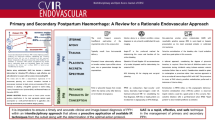Abstract
The purpose of this retrospective study was to evaluate the role of transcatheter arterial embolization in the management of severe postpartum haemorrhage due to a ruptured pseudoaneurysm and to analyse the clinical symptoms that may suggest a pseudoaneurysm as a cause of postpartum haemorrhage. A retrospective search of our database disclosed seven women with severe postpartum haemorrhage in whom angiography revealed the presence of a uterine or vaginal artery pseudoaneurysm and who were treated using transcatheter arterial embolization. Clinical files were reviewed for possible clinical findings that could suggest pseudoaneurysm as a cause of bleeding. Angiography revealed extravasation of contrast material in five out of seven patients. Transcatheter arterial embolization allowed to control the bleeding in all patients and subsequently achieve vaginal suture in four patients with vaginal laceration. No complications related to transcatheter arterial embolization were noted. Only two patients had uterine atony, and inefficiency of sulprostone was observed in all patients. Transcatheter arterial embolization is an effective and secure technique for the treatment of severe postpartum haemorrhage due to uterine or vaginal artery pseudoaneurysm. Ineffectiveness of suprostone and absence of uterine atony should raise the possibility of a ruptured pseudoaneurysm.



Similar content being viewed by others
References
Jouppila P (1995) Postpartum haemorrhage. Curr Opin Obstet Gynecol 7:446–450
Alvarez M, Lockwood CJ, Ghidini A, Dottino P, Mitty HA, Berkowitz RL (1992) Prophylactic and emergent arterial catheterization for selective embolization in obstetric hemorrhage. Am J Perinatol 9:441–444
Pelage JP, Le Dref O, Mateo J, Soyer P, Jacob D, Kardache M et al (1998) Life-threatening primary postpartum hemorrhage: treatment with emergency selective arterial embolization. Radiology 208:359–362
Pelage JP, Soyer P, Repiquet D, Herbreteau D, Le Dref O, Houdart E et al (1999) Secondary postpartum hemorrhage: treatment with selective arterial embolization. Radiology 212:385–389
Combs CA, Murphy EL, Laros RK Jr (1991) Factors associated with postpartum hemorrhage with vaginal birth. Obstet Gynecol 77:69–76
Khong TY, Khong TK (1993) Delayed postpartum hemorrhage: a morphologic study of causes and their relation to other pregnancy disorders. Obstet Gynecol 82:17–22
Kwon JH, Kim GS (2002) Obstetric iatrogenic arterial injuries of the uterus: diagnosis with US and treatment with transcatheter arterial embolization. Radiographics 22:35–46
Langer JE, Cope C (1999) Ultrasonographic diagnosis of uterine artery pseudoaneurysm after hysterectomy. J Ultrasound Med 18:711–714
Wald DA (2003) Postpartum hemorrhage resulting from uterine artery pseudoaneurysm. J Emerg Med 25:57–60
Zimon AE, Hwang JK, Principe DL, Bahado-Singh RO (1999) Pseudoaneurysm of the uterine artery. Obstet Gynecol 94:827–830
Bromley PJ, Clark T, Weir IH, Zwirewich CV (1997) Radiologic diagnosis and management of uterine artery pseudoaneurysm: case report. Can Assoc Radiol J 48:119–122
McGonegle SJ, Dziedzic TS, Thomas J, Hertzberg BS (2006) Pseudoaneurysm of the uterine artery after an uncomplicated vaginal delivery. J Ultrasound Med 25:1593–1597
Combs CA, Murphy EL, Laros RK Jr (1991) Factors associated with hemorrhage in cesarean delivery. Obstet Gynecol 77:77–82
Brunschwig A, Brockunier A (1960) Postoperative rupture of major vessels after radical pelvic operation. Am J Obstet Gynecol 80:485–489
Cooper BC, Hocking-Brown M, Sorosky JI, Hansen WF (2004) Pseudoaneurysm of the uterine artery requiring bilateral uterine artery embolization. J Perinatol 24:560–562
Eason DE, Tank RA (2006) Avoidable morbidity in a patient with pseudoaneurysm of the uterine artery after cesarean section. J Clin Ultrasound 34:407–411
Deux JF, Bazot M, Le Blanche AF, Tassart M, Khalil A, Berkane N et al (2001) Is selective embolization of uterine arteries a safe alternative to hysterectomy in patients with postpartum hemorrhage? AJR 177:145–149
Pelage JP, Soyer P, Le Dref O, Dahan H, Coumbaras J, Kardache M et al (1999) Uterine arteries: bilateral catheterization with a single femoral approach and a single 5-F catheter-technical note. Radiology 210:573–575
Pelage JP, Le Dref O, Soyer P, Jacob D, Kardache M, Dahan H et al (1999) Arterial anatomy of the female genital tract: variations and relevance to transcatheter embolization of the uterus. AJR 172:989–994
Haseltine FP, Glickman MG, Marchesi S, Spitz R, Dlugi A, DeCherney AA (1984) Uterine embolization in a patient with postabortal hemorrhage. Obstet Gynecol 63:78S–80S
Fleming H, Ostor AG, Pickel H, Fortune DW (1989) Arteriovenous malformations of the uterus. Obstet Gynecol 73:209–213, 1984;63 (3suppl):78–80
Itoh H, Keitoku M, Fukuoka M, Sagawa N, Mori T, Togashi K (1997) Spontaneous resolution of a postcesarean arteriovenous fistula of the uterine cervix: the usefulness of transvaginal color Doppler scanning. J Obstet Gynaecol Res 23:439–444
Goffinet F, Haddad B, Carbonne B, Sebban E, Papiernik E, Cabrol D (1995) Practical use of sulprostone in the treatment of hemorrhage during delivery [in French]. J Gynecol Obstet Biol Reprod 24:209–216
Yamashita Y, Takahashi M, Ito M, Okamura H (1991) Transcatheter arterial embolization in the management of postpartum hemorrhage due to genital tract injury. Obstet Gynecol 77:160–163
Lang EK (1981) Transcatheter embolization of pelvic vessels for control of intractable hemorrhage. Radiology 140:331–339
Cottier JP, Fignon A, Tranquart F, Herbreteau D (2002) Uterine necrosis after arterial embolization for postpartum hemorrhage. Obstet Gynecol 100(5Pt2):1074–1077
Yamashita Y, Harada M, Yamamoto H, Miyazaki T, Takahashi M, Miyazaki K et al (1994) Transcatheter arterial embolization of obstetric and gynaecological bleeding: efficacy and clinical outcome. Br J Radiol 67:530–534
Dönmez H, Öztürk MH, Gürgen F, Soylu SÖ, Hekimoglu B (2007) Intractable hemorrhage resulting from uterine artery pseudoaneurysm: superselective arteriographic embolization via the collateral route. Cardiovasc Intervent Radiol 30:310–312
Markoff G, Quagliarello J, Rosen RJ, Beckman EM (1986) Uterine arteriovenous malformation successfully embolized with a liquid polymer, isobutyl 2-cyanoacrylate. Am J Obstet Gynecol 155:659–660
Kovo M, Behar DJ, Friedman V, Malinger G (2007) Pelvic arterial pseudoaneurysm-a rare complication of Cesarean section: diagnosis and novel treatment. Ultrasound Obstet Gynecol 30:783–785
Author information
Authors and Affiliations
Corresponding author
Rights and permissions
About this article
Cite this article
Soyer, P., Fargeaudou, Y., Morel, O. et al. Severe postpartum haemorrhage from ruptured pseudoaneurysm: successful treatment with transcatheter arterial embolization. Eur Radiol 18, 1181–1187 (2008). https://doi.org/10.1007/s00330-008-0876-2
Received:
Revised:
Accepted:
Published:
Issue Date:
DOI: https://doi.org/10.1007/s00330-008-0876-2




